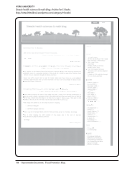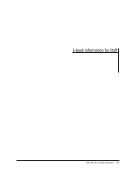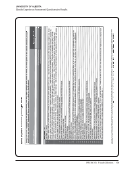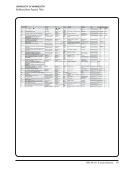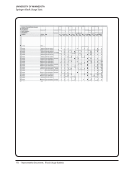72 · Survey Results: Survey Questions And Responses
Additional Comments
31. Please enter any additional information about e-book collection building and use at your library
that may assist the authors in accurately analyzing the results of this survey. N=20
Additional concern about e-books is the problem of accessing multiple platforms.
Although we have acquired a fairly large number of e-books, we have been relatively passive about this e-books are
happening to us rather than being actively or systematically pursued. If budgets had not been so tight in recent years,
and especially now, we might have done more experimenting with e-books to see if a greater supply would produce
a greater demand. But as things stand now, we’re going to direct any spare money we have towards acquisitions that
users have consistently and loudly demanded, which is not e-books at present. Our e-book collecting will continue
to be incidental, piecemeal, and sporadic until we have a stronger mandate from our users and the money to carry it
out. This may not be as proactive as libraries like to think of themselves as being, but there is such a thing as being
too far ahead of the curve, especially when your pockets are empty!
Except for a few study abroad programs/classes, all students at my university are on one of two campuses (medical
and non-medical) which are three miles apart. We do not have the off-site learning programs that many universities
have. Thus, we have been able to ignore individual e-books.
I regularly communicate to publishers and aggregators that the business model that assumes buying big batches
of books and a ‘steep discount’, but nevertheless costs more than we would normally spend for books from that
publisher or in that subject, is not a model we can easily support. They are reluctant, still, to make all of the e-books
easily available for title-by-title purchase. Both options need to be fully available.
I’m not seeing much of an increase in the number of publishers who are offering their content electronically.
Simultaneous release is still more of a promise than a reality. Many publishers have unrealistic expectations for what
their content should be worth online.
Many new reference materials are being purchased as e-only we entered into an agreement with our monograph
vendor to order Sage and NetLibrary books individually in the last six months.
Our comments reflect, for the most part, e-books in context of trade/scholarly publications however, our library is a
full depository library for government publications, and most of these (perhaps over 90%) e-books are not listed in
the catalogue. We have approx. 300,000 e-books in the catalogue but this represents a fraction of what we own/
license. The rest are accessible through various means, including a separate site for e-books/e-books Collections,
branch/unit Web pages, finding lists, etc. Often this accessibility is a barrier, requiring users’ expert knowledge and/or
librarians’ ability to educate through Outreach programs, instruction programs, and wherever possible, via reference
activities.
Our efforts have focused on reference materials over monographs.
Readers such as the Kindle are going to, in my opinion, create 3 categories of books: print, online, and device
books. We currently offer print and online, but are very week in device. E-book really means online book. And online
collections may not be so valuable in the future if readers catch on and our online collections are not portable to
readers.
Still a relatively new format. Still mixing individual purchases with collections. Still trying to sort out appropriate mix of
print vs electronic. Stay tuned.
Additional Comments
31. Please enter any additional information about e-book collection building and use at your library
that may assist the authors in accurately analyzing the results of this survey. N=20
Additional concern about e-books is the problem of accessing multiple platforms.
Although we have acquired a fairly large number of e-books, we have been relatively passive about this e-books are
happening to us rather than being actively or systematically pursued. If budgets had not been so tight in recent years,
and especially now, we might have done more experimenting with e-books to see if a greater supply would produce
a greater demand. But as things stand now, we’re going to direct any spare money we have towards acquisitions that
users have consistently and loudly demanded, which is not e-books at present. Our e-book collecting will continue
to be incidental, piecemeal, and sporadic until we have a stronger mandate from our users and the money to carry it
out. This may not be as proactive as libraries like to think of themselves as being, but there is such a thing as being
too far ahead of the curve, especially when your pockets are empty!
Except for a few study abroad programs/classes, all students at my university are on one of two campuses (medical
and non-medical) which are three miles apart. We do not have the off-site learning programs that many universities
have. Thus, we have been able to ignore individual e-books.
I regularly communicate to publishers and aggregators that the business model that assumes buying big batches
of books and a ‘steep discount’, but nevertheless costs more than we would normally spend for books from that
publisher or in that subject, is not a model we can easily support. They are reluctant, still, to make all of the e-books
easily available for title-by-title purchase. Both options need to be fully available.
I’m not seeing much of an increase in the number of publishers who are offering their content electronically.
Simultaneous release is still more of a promise than a reality. Many publishers have unrealistic expectations for what
their content should be worth online.
Many new reference materials are being purchased as e-only we entered into an agreement with our monograph
vendor to order Sage and NetLibrary books individually in the last six months.
Our comments reflect, for the most part, e-books in context of trade/scholarly publications however, our library is a
full depository library for government publications, and most of these (perhaps over 90%) e-books are not listed in
the catalogue. We have approx. 300,000 e-books in the catalogue but this represents a fraction of what we own/
license. The rest are accessible through various means, including a separate site for e-books/e-books Collections,
branch/unit Web pages, finding lists, etc. Often this accessibility is a barrier, requiring users’ expert knowledge and/or
librarians’ ability to educate through Outreach programs, instruction programs, and wherever possible, via reference
activities.
Our efforts have focused on reference materials over monographs.
Readers such as the Kindle are going to, in my opinion, create 3 categories of books: print, online, and device
books. We currently offer print and online, but are very week in device. E-book really means online book. And online
collections may not be so valuable in the future if readers catch on and our online collections are not portable to
readers.
Still a relatively new format. Still mixing individual purchases with collections. Still trying to sort out appropriate mix of
print vs electronic. Stay tuned.
















































































































































